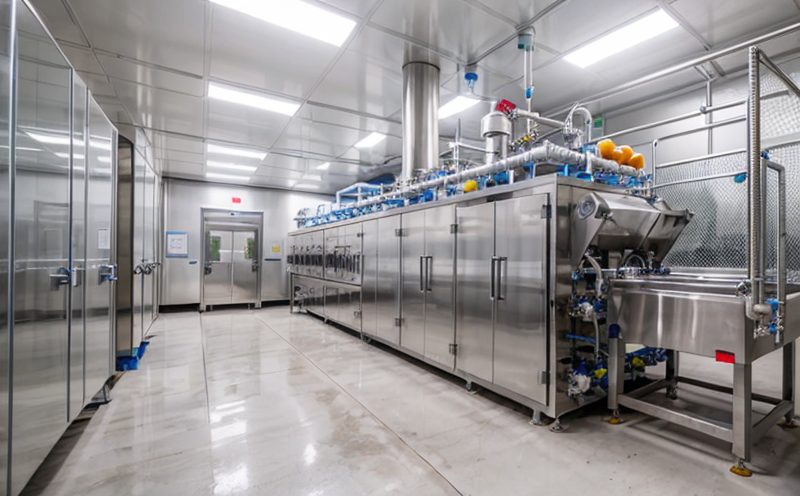Food production facility hygiene inspection
The food safety and hygiene inspection is a critical component in ensuring the quality and integrity of food products. A well-executed hygiene inspection helps to identify potential risks that could lead to contamination, such as microbial growth, chemical contamination, or cross-contamination between different food items. This process ensures compliance with international standards like ISO 22000, which is the internationally recognized standard for food safety management systems.
Hygiene inspections are not just about cleanliness; they also involve assessing the overall environment in which food production takes place. This includes checking the cleanliness of surfaces, equipment, and utensils used during the manufacturing process. It's important to note that these inspections should be carried out regularly and not just when there is a perceived issue. By conducting routine checks, companies can prevent minor issues from becoming major problems.
During an inspection, quality managers typically use various tools such as swabs or air samplers to collect samples for analysis. These samples are then sent to accredited laboratories where they undergo rigorous testing according to international standards like ASTM E1220 which specifies methods for the collection of microbial specimens from surfaces.
The aim is not only to ensure that hygiene practices meet regulatory requirements but also to improve operational efficiency. For instance, by identifying and addressing areas where hygiene standards are not being met, companies can reduce waste, minimize downtime due to recalls, and enhance customer satisfaction. Compliance with these standards also helps build trust among consumers who increasingly demand transparency about how their food is produced.
It's worth noting that while physical cleanliness plays a significant role in maintaining high levels of hygiene, it isn't the only factor. Factors such as temperature control during storage and transportation, pest management practices, personal hygiene protocols for employees, and proper handling procedures all contribute to overall food safety. Therefore, comprehensive inspections should cover every aspect of the production process.
Regular audits by independent third parties can provide additional assurance that facilities are meeting both internal and external expectations regarding hygiene standards. Such audits help identify any gaps in current practices early on so they can be addressed promptly before they escalate into larger issues. Implementing effective hygiene measures isn't just about following regulations; it's about protecting public health while maintaining brand reputation.
By investing time and resources into regular inspections, food production facilities can create a safer working environment for all employees involved in the manufacturing process. This proactive approach not only enhances operational efficiency but also contributes positively towards achieving long-term business goals by fostering customer confidence and loyalty.
Applied Standards
The application of appropriate standards ensures that food production facilities maintain high levels of hygiene at all times. One such standard is ISO 22000:2018, which provides a framework for food safety management systems within organizations involved in the manufacture, distribution, or supply of foods.
Another important standard is ASTM E1220-16, which specifies methods for collecting microbial specimens from surfaces. This includes procedures for sampling, transporting, and preserving samples to ensure accurate testing results.
Additionally, EN 35098:2016 sets out requirements for the design, construction, installation, commissioning, operation, maintenance, and decommissioning of hygiene systems in food manufacturing installations. Compliance with this standard helps ensure that all aspects of the facility are designed to minimize contamination risks.
The use of these standards ensures consistency across different locations within a company as well as between companies operating under similar conditions. It provides a common language for communicating expectations and achieving desired outcomes regarding hygiene practices.
Benefits
- Reduces risk of contamination leading to recalls or legal action.
- Improves operational efficiency by minimizing downtime due to issues arising from poor hygiene practices.
- Promotes better working conditions for employees involved in food production processes.
- Enhances customer confidence and loyalty through consistent adherence to high standards of hygiene.
Use Cases and Application Examples
In practice, a food production facility might undergo an inspection before certification or accreditation. This ensures that the facility meets all necessary criteria set by regulatory authorities prior to being allowed to operate publicly. Another scenario could involve post-incident investigations where detailed records of previous inspections are reviewed alongside current findings to determine root causes and appropriate corrective actions.
For instance, a dairy farm might need periodic checks to verify that pasteurization equipment is functioning correctly and that milk storage areas remain at safe temperatures throughout the supply chain. Similarly, meat processing plants would focus on ensuring proper chilling facilities and preventing cross-contamination between different types of meats during packaging processes.





